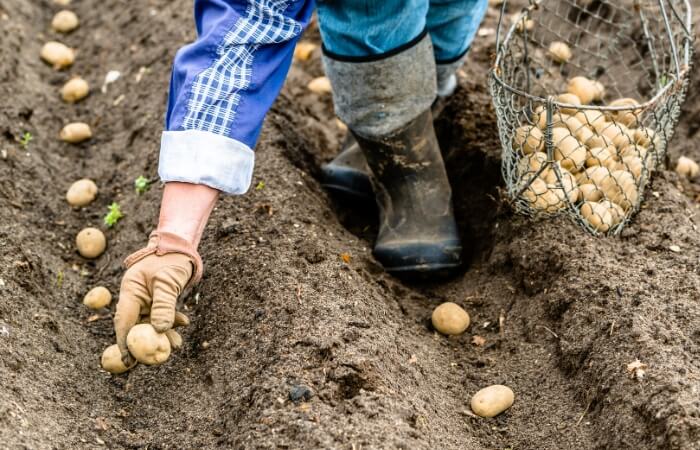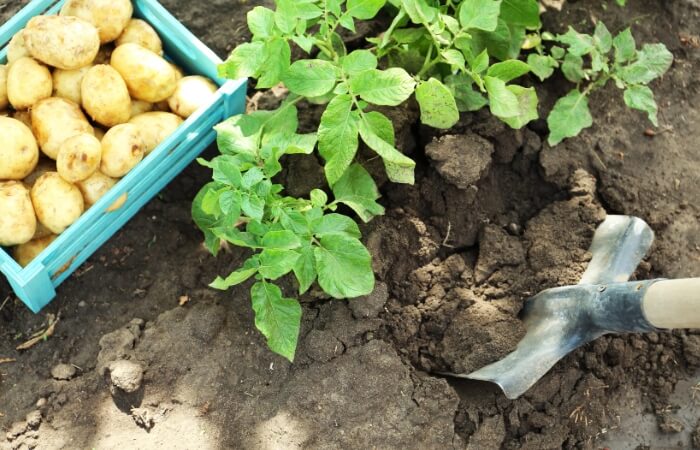Gardening doesn’t always go as planned, but when is it too late to plant potatoes and still harvest before winter?
The answer depends on your location, as temperature variations play a huge role in when you can plant potatoes.

To help you sort out when it’s too late in the season to plant potatoes and tips for getting a crop from a late start, you only need to read this guide.
By the end, you’ll see that a delay getting your potatoes in the ground doesn’t need to prevent you from enjoying a bountiful potato harvest!
When Is It Too Late To Plant Potatoes?
For spring gardening, planting potatoes after May will likely result in two problems.
- The first is not having sufficient time for the potatoes to mature and form tubers before the year’s first frost.
- The second is avoiding warm soil temperatures in mid and late summer that can halt tuber formation altogether.
Potatoes love growing in cool soil, so early spring and fall are always the best time of year to plant, but this isn’t always possible.
Many people new to gardening may not be aware that plenty of potato varieties require over 100 days to mature, with several that require 135 days.
An ideal rule of thumb is to allow four solid months of growing time to develop a potato crop, so planting seed potatoes in June could leave you in a time pinch if you live in a northern climate.
For warmer regions of the country, you have to avoid the harsh summer heat. This issue may delay your potato planting schedule as well, even if you usually plant potatoes as a fall crop.
It’s too late to plant potatoes in warm regions after January or February for a spring crop and September for a fall harvest.
You need to avoid soil temperatures that hit 80°F (27°C), which can happen in the summer, and freezing soil in the late fall and winter months.
Having a quality soil thermometer is a fantastic tool for both monitoring soil so it reaches the 45°F (7°C) minimum for getting spuds in the ground and watching for soil getting too hot so you can shade the area.
The encouraging news is there are many ways to alter your potato planting when you get a late start so that you can avoid both the heat and frost, so check out the tips up next.
Tips For Planting Late Potatoes
Use the tips below when you think it may be too late to plant potatoes in your garden. You may be able to use these methods to your benefit.
Choose The Right Variety
The best way to increase the success of and taste of potatoes you plant late is to choose a quicker-maturing variety such as:
- Irish Cobbler
- Yukon Gold
- Norland
- Kennebec
- Rio Grande
- Red Pontiac
These early-season potatoes can mature in 75-90 days, so you have more leeway to plant later than usual and still achieve a good harvest before the weather becomes unsuitable for further growth.
If you are planting potatoes only 1-3 weeks late, you should consider mid-season potato varieties that require 95-110 days to mature, such as:
- Daisy Gold
- Red Gold
- Norland
- Magic Molly
- Chieftan
Watch Out For Heavy Rains
Another thing to watch out for if your area gets consistent rainfall is to ensure your garden soil drains well, as seed potatoes can quickly rot and die in soaking-wet dirt.
A good tip is to use raised beds for potatoes to help soil drainage to prevent your potatoes from rotting underground.
You can also plant your potatoes at nearly ground level and hill up the dirt around the plants so more of the root system is higher in the soil.
Harvest New Potatoes
Another tip is to harvest new potatoes, which are younger tubers with thin skins.
Once you see your potato plants stop flowering, you only need to wait two weeks to dig up these tender, small taters.

If you don’t see your potatoes flowering (some varieties won’t), you’ll need to do a test dig and see how large the tubers have grown so you can pull them at your favorite size.
Flowering on potato plants isn’t an indication of tuber growth. All plants should form potatoes, but gardeners often rely on the flowers to know that harvesting will start about a month later.
Without flowers, look for wilting, brown, and dry foliage as signs your potato crop is mature.
Watch The Sun
Potatoes need six hours of sun a day for optimal growth, but intense sun in the heat of summer can trigger the plant’s instincts to stop tuber development.
If you live where hot soil is a potential threat, have some shade cloth ready.
If your soil thermometer is climbing above 70°F (21°C), drape the cloth over your potatoes during the hottest part of the day to keep the soil cooler to allow the tubers to keep growing.
In Summary
Potatoes are so versatile for cooking and are one of few crops a gardener can store.
Being able to grow such a convenient vegetable, even with a late start, by using the information in this guide can provide beneficial nutrients for months after harvest. When you plan your garden using the tips above, tasty taters are within your reach!










